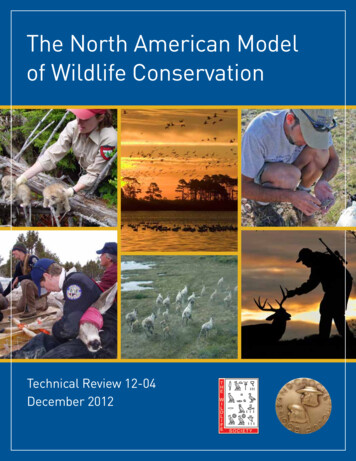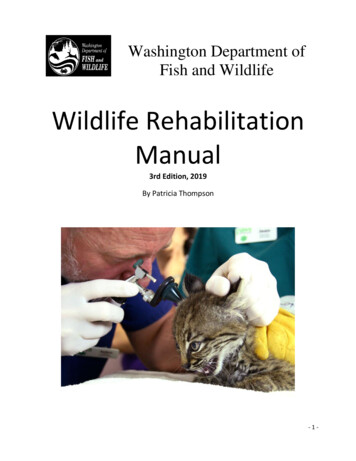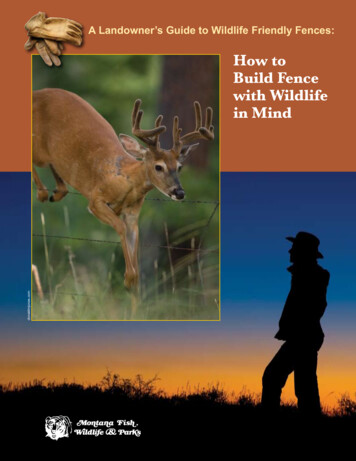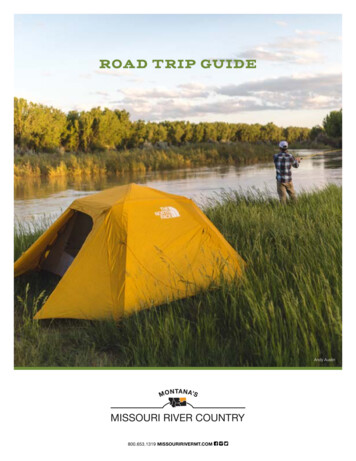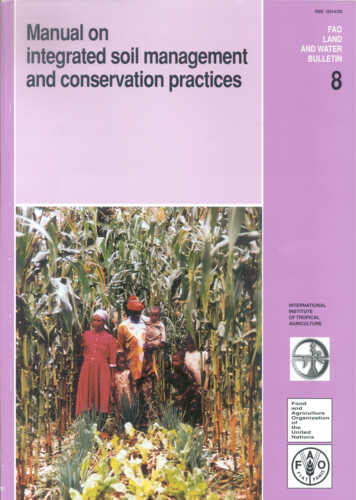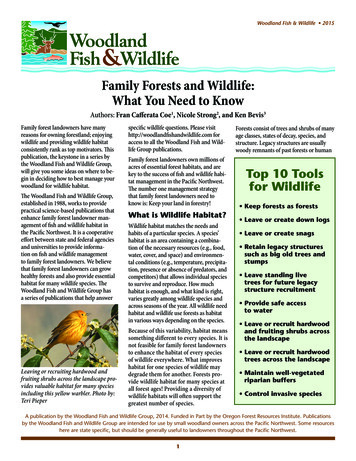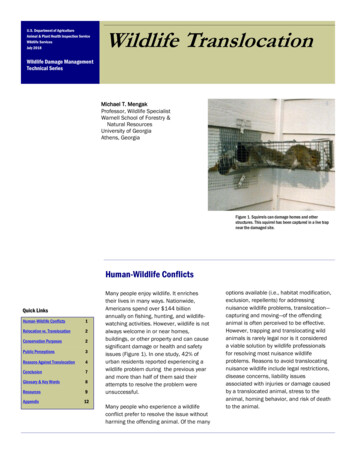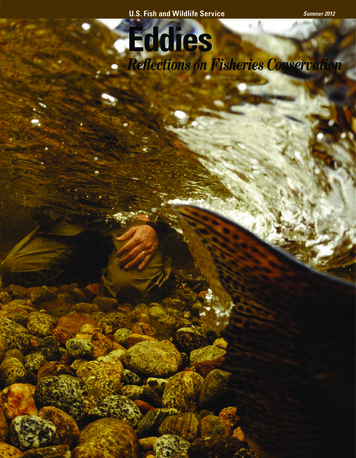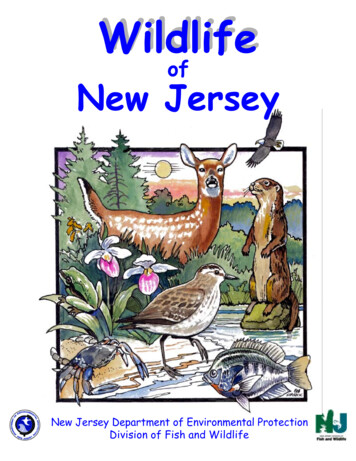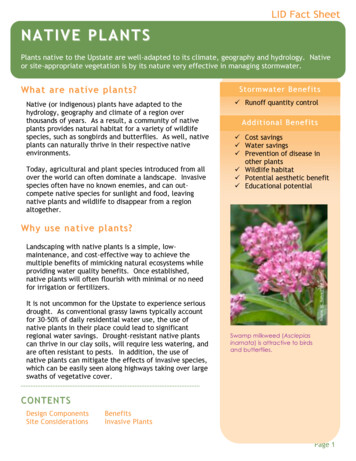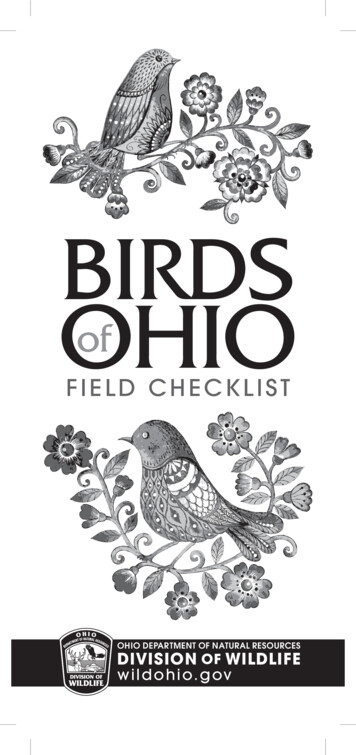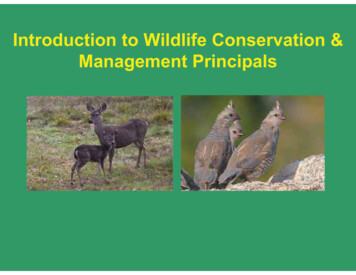
Transcription
Introduction to Wildlife Conservation &Management Principals
Key Topics Wildlife Conservation Management & Conservation Principles
Wildlife ConservationConcept of wildlife conservation has beenaround since ancient times. Restrictions ontaking game are mentioned in the Bible, firstofficial hunting season may have beenestablished in the 13th century by KublaKahn.
Wildlife Conservation (cont.)Today, wildlife conservation has evolved intoa science, but its goal remains essentially thesame: to ensure the wise use andmanagement of renewable resources. Giventhe right circumstances, living organisms thatwe call renewable resources can replenishthemselves indefinitely. Conservation: Is the wise use of naturalresources, without wasting them.
Preservation Preservation: (Saving natural resources,but with no consumption of them), isanother means of protecting or saving aresource, such as outlawing hunting ofendangered species. Both preservation andconservation are necessary to sustainresources for future generations.
Lessons in Wildlife Management Early attempts at wildlife management inthe United States were skewed towardprotection and preservation.– A reaction to widespread declines due tounregulated subsistence and markethunting. .
Lessons in Wildlife Management(cont.) In the early 1900s, wildlife managersattempted to preserve a mule deer herd inthe remote Kaibab Plateau of Arizona.Hunting was banned, and predators weredestroyed. The result was severeoverpopulation, habitat destruction andmass starvation
Lessons in Wildlife Management (cont.) The Kaibab Plateau was opened tomanaged hunting in 1929, which broughtthe population into balance with the habitat.Today, a large, healthy herd of mule deerinhabits the area.
Lessons in Wildlife Management (cont.) Wildlife managers learned there is more toconservation than just protecting wildlife.They discovered that nature overproducesits game resources, and that good wildlifemanagement yields a surplus that can beharvested by hunters, trappers, andanglers.
Habitat ManagementMost critical aspect ofwildlife conservation ishabitat management.Habitat loss presents thegreatest threat to wildlife.
Habitat Management (cont.)These five essential elements must be present: The need for food and water is obvious. Cover is needed forshelter as well as toprotect animals whilefeeding, breeding,roosting, nesting,traveling.and
Habitat Management (cont.) Space is necessary to avoid over-competitionfor food. Some animals also need a certainamount of territorial space for mating andnesting. Arrangement refersto the placement offood, water, coverand space in ahabitat.
Habitat Management (cont.) For example, quail will spend much of theirtime where shrub and grassland areasconverge. This is called edge effect. Mostanimals can be found where food and covermeet, particularly near a water source.River bottoms are ideal, offering manyanimals all their habitat needs along onecorridor.
Balancing ActHabitats must be in balance in order to supportwildlife. Remove a certain population of plants oranimals from a community, and the communitymay not survive. This typically happens whenurban development pushes into wildlife areas.
Carrying CapacityResources in any given habitat can supportonly a certain quantity of wildlife. Asseasons change, food, water, or cover maybe in short supply. Carrying capacity isnumber of animals habitat can support allyear long. Carrying capacity of a certaintract of land can vary from year to year. Itcan be changed by nature or humans.
Limiting FactorsFactors that limit potential production of wildlifeinclude: Disease and starvation Predators and hunting Pollution Accidents Old Age
Limiting Factors (cont.)If the conditions are balanced, game animals willproduce a surplus, which can be harvested.
The Hunter’s Role in Wildlife ConservationSince wildlife is a renewable resource withsurplus, hunters can help maintain wildlifepopulations at a healthy balance for thehabitat. Regulated hunting should neverlead to threatened or endangered wildlifepopulations.Hunting is effective wildlife managementtool. Hunters play important role byproviding information from the field thatwildlife managers need.
The Hunter’s Role in Wildlife Conservation(cont.)Funding from hunting licenses has helpedmany game and non-game species recoverfrom dwindling populationsIn addition to participating in the harvest ofsurplus animals, hunters help sustain gamepopulations by:
The Hunter’s Role in Wildlife Conservation(cont.) Filling out questionnaires Participating in surveys Stopping at hunter checkstations Providing samples from harvested animals Funding for wildlife management throughlicense fees.
Management/Conservation PrinciplesWildlife manager’s job is to maintain numberof animals in a habitat at or below habitat’scarrying capacity, so no damage is done tothe animals or to their habitat.In addition to looking at the total number of aspecies in a habitat, wildlife managers alsomonitor breeding stock correct mix of adultand young animals needed to sustain apopulation.
Management/Conservation Principles(cont.)To manage a habitat, wildlife managersmust consider historical trends, currenthabitat conditions, breeding populationlevels, long-term projections and breedingsuccess.
Wildlife Management Practices Monitoring Wildlife Populations:Wildlife managers continuouslymonitor birth and death rate of variousspecies and condition of their habitat.This provides data needed to sethunting regulations and determine ifother wildlife management practicesare needed to conserve wildlifespecies.
Wildlife Management Practices (cont.) Habitat Improvement: As successionoccurs, change in habitat affects type andnumber of wildlife habitat can support.Wildlife managers may cut down or burnforested areas to promote new growth andslow down the process of succession. Thispractice enables them to increase theproduction of certain wildlife species.
Wildlife Management Practices (cont.) Hunting Regulations: Hunting regulationsprotect habitat and preserve animalpopulations. Regulations include settingdaily and seasonal time limits, bag limitsand legal methods for taking wildlife.
Beneficial Habitat Management Practices Food plots and planting Controlled burning Brush pile creation Timber cutting Ditching Diking Nuisance plant or animal control Mechanical brush or grass control Water holdings
Birth RateNumber of young born to a wildlife species in one year.Death RateNumber of individuals that die in one year.SuccessionNatural progression of vegetation and wildlife populationsof an area; for example, as trees grow and form a canopy,shrubs and grasses will disappear along with the wildlifethat use them for food and cover.PredatorAn animal that kills other animals for food
Wildlife Management Tools Laws: Wildlife laws must be flexible,based on biological facts, and used incombination with other managementtools. These game laws are necessaryto protect the safety of people, toprotect the game, and to insure a fairshare for future generations.
Wildlife Management Tools (cont.) Habitat Management: Ideal goal is manipulatevegetation so necessities for life for variety ofwildlife are provided. Generally this is done bycontrolled burning, selective forestry, foodplanting where feasible and appropriate, andother practices to maintain proper mix of habitatrequirements. Stocking: Purpose of stocking is release wildlifespecies in areas that have suitable habitat but noanimal population.
Wildlife Management Tools (cont.) Hunting and Trapping: Valuable tools formaintaining wildlife populations at or belowcarrying capacity for the habitat. Goal is regulatehunting so only excess animals in a populationare removed. Public Education: Necessary for publicunderstanding of wildlife managementprograms. The more people know andunderstand wildlife and its needs, the more likelythey will support management programs.
Questions?
taking game are mentioned in the Bible, first official hunting season may have been established in the 13th century by Kubla . hunters help sustain game populations by: The Hunter’s Role in Wildlife Conservation . Wildlife manager’s
